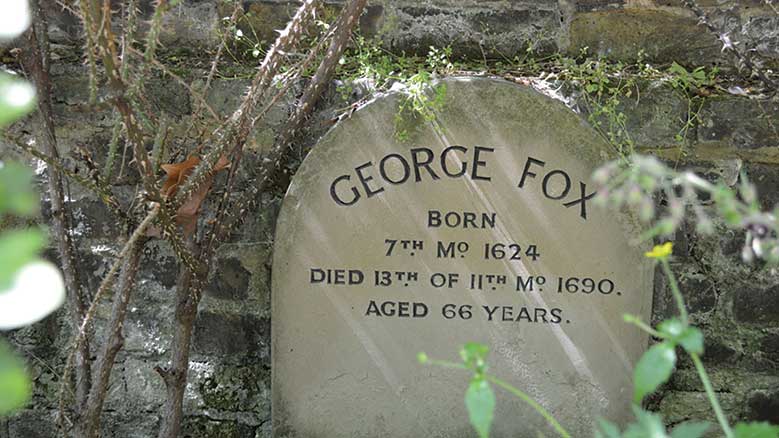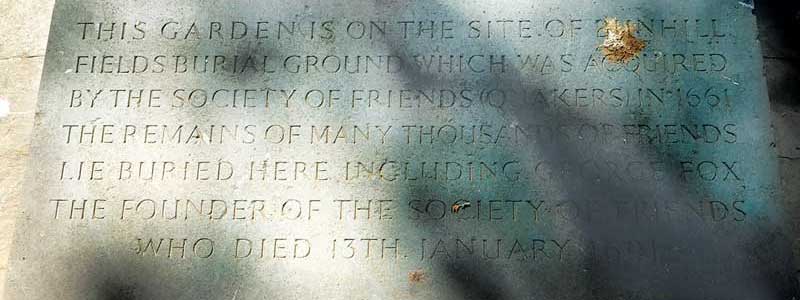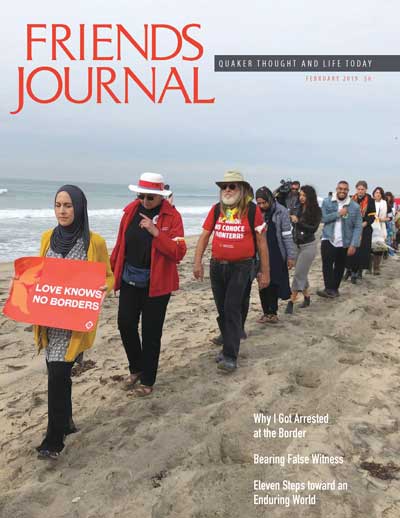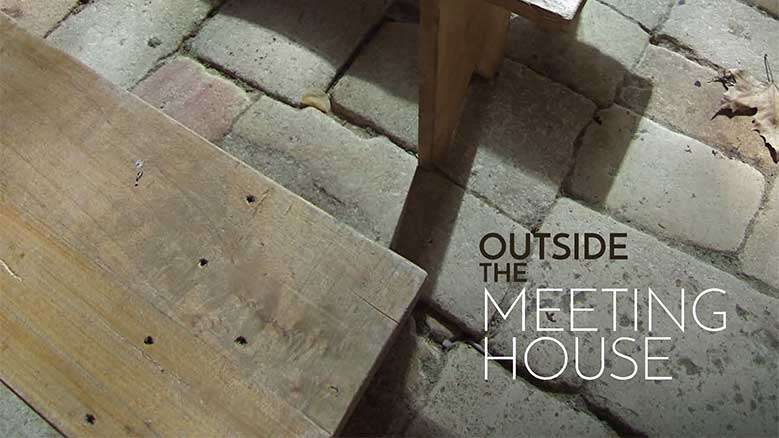
While in London last summer, I left my family to sleep in one morning, and caught the Underground to the Borough of Islington in search of George Fox.
I wanted to find Fox’s grave and pay homage to the energetic, stubborn, brilliant, kindly man who was a central founder of our faith. I was sorely disappointed—and then profoundly glad—because I never found it.
Like many people, I’m obsessed with history. I’ve visited museums, castles, battlefields, churches, temples, meetinghouses, and also the graves of many famous people whom I admire.
Visiting such sites stems from a desire to connect with our collective past, to see places where momentous events took place. But do pilgrimages to graves make spiritual sense for a Quaker? My conclusion after the London trip is no.
The messy history of George Fox’s grave underscores how Quakers have long wrestled against a common human impulse—probably as old as consciousness—to build monuments at grave sites, to see them as somehow holy places.
Early Quakers eschewed elaborate tombstones, forbidding any special markers showing the dead’s wealth or importance. Rich, poor, famous writers of Quaker tracts, those that died as martyrs in English prisons—they were all buried in fields with same-sized, unmarked stones. The spiritual message was simple: the dead, like the living, are all equal before God. No one was more important than anyone else in the Religious Society of Friends or outside of it.
At least that was how it was supposed to be. But what if the person was considered a founder of the faith? I assumed Fox would have something more distinguished as my train rattled underground toward Islington.

Quakers continued to come on pilgrimages to see the stone, until one particularly iconoclastic Quaker by the name of Robert Howard had it smashed to bits as idolatrous.
Fox died in January 1691. An account from a Quaker witness, Robert Barrow, said more than 4,000—”a large and living assembly of God’s chosen people”—gathered for the memorial service, spilling out from London’s Gracechurch Street Meetinghouse into the surrounding streets. William Penn and others in attendance wept and groaned. Many walked north with the coffin to the Quaker’s Bunhill Fields burial grounds, for more speeches and the burial. Against Friends custom, a headstone was placed for Fox in the rocky field. Quickly, the site became a standard pilgrimage for Quakers visiting London. The marker was removed in 1757 as the grounds expanded, and it was replaced with a small stone that simply read “G.F.” Quakers continued to come on pilgrimages to see the stone, until one particularly iconoclastic Quaker by the name of Robert Howard had it smashed to bits as idolatrous. The Quaker burial grounds grew and grew over the decades, eventually holding the remains of about 12,000 people. Only Fox ever had a marker. The fields closed to more burials in 1855.
In the 1870s, Quakers were forced to sell a large part of the grounds to the municipal government to expand roads and add buildings for growing London. In the process, the remains of about 5,000 Quakers were dug up and reinterred on the remaining property, less than a half acre. With money from the sale of the land, Quakers erected several buildings, including a large meetinghouse. In 1881, they built a small garden on the remaining burial area—and again the old impulse to memorialize Fox arose. They added a new headstone on the site where they thought he was buried. It didn’t last. During World War II, Nazi bombs hit the area and destroyed the main meetinghouse and other buildings. Only a small caretaker’s house was saved (it is home to the small Bunhill Meeting to this day). In the 1950s, public housing was built around the garden, which was revamped. Again a small plaque was put up, mentioning Quakers buried beneath, but the only person mentioned by name is Fox.

How could this sorry stone be all there is to mark this great man’s grave? How could Quakers have lost track of the precise location of his grave?
Today, the last vestige of the once-sprawling burial grounds—a tiny garden area—sits surrounded by the Quaker caretaker building, council apartments, a playground, and a ball court. It took me a while to find it, even with my iPhone, but eventually I made my way to the front gate.
It was a sweltering day. The United Kingdom was suffering the hottest period of drought since 1976. Most of the little park was gray dirt, and the rest of it overgrown shrubbery in the shade of a few trees. Two homeless men slept on benches. An abandoned shopping cart stood to the side of a mud path. Trash was strewn on the ground. I wandered about quietly until I found the small 1950s stone marker, covered in dust and bird droppings. It was all very squalid. I thought there would be some kind of obelisk, tombstone, or statue.
Somewhere here were the remains of the man who climbed Pendle Hill and saw God’s vision of “a great people to be gathered”; who suffered in prison for his beliefs; who traveled all over England and to America and Barbados to convince people to reject paid clergy, embrace simplicity, and gather in silence to listen for spiritual messages. How could this sorry stone be all there is to mark this great man’s grave? How could Quakers have lost track of the precise location of his grave?
As long as humanity has organized into societies, it has memorialized its dead. Ziggurats and pyramids rose, and people built temples to deities. Sir Thomas Browne, the English theologian and philosopher, wrote a whole treatise on burial monuments. He was not a Quaker, but I like to think he held Quaker-ish notions on the universality of humankind—an “invisible sun” that lives within all of us—as well as the impermanence of monuments to the dead.
In his 1658 essay, Browne wrote that the powerful and wealthy tried to preserve their names after death, but others—I would argue including Quakers—were content “to return into their unknown and divine Original again.”
The notion of a grave marker for a man who spent his life rejecting self-aggrandizement and social hierarchies suddenly struck me as very unquakerly.
As I stood there silently in the small Quaker garden, the message came to me: why am I seeking some kind of stone monument for Fox? Would a marker on this spot strengthen my spirituality? Would a statue or obelisk give some permanence to the religion? Of course not.
Somewhere below my feet, mixed with mud, roots, stones; bits of old brick and Nazi bombs; Dickensian soot; perhaps some Medieval and Roman coins; and of course the remains of thousands of other Quakers, were what was left of the physical remains of the man named George Fox. But no one has any idea where exactly, and I realized it doesn’t really matter.
The notion of a grave marker for a man who spent his life rejecting self-aggrandizement and social hierarchies suddenly struck me as very unquakerly. We are a faith based upon the principle that no one is better than anyone else because of social standing or alleged “importance.” And we are a faith focused on the living, not the dead.
After Fox died, Quakers found a sealed letter that he wrote labeled, “Not to be opened before the time.” In that letter, he wrote that in heavenly Jerusalem, there were no schisms, no divisions among different people, and “a spiritual house, composed of living stones.”
I assume Fox saw those stones as unmarked—and all about the same size. I’ll still putter around historical sites. I can’t help that impulse. But no more pilgrimages to Quaker graves. What I am seeking isn’t there.






I really enjoyed this. Thank you.
You could go to Fenny Drayton where there’s a rather splendid memorial stone to George Fox, and not a bit Quakerly!
Thank you for this thoughtful article. it gives me food for thought on a matter I have been considering. My father has no marker where his ashes are buried, in the grave site where my mother is buried. I have pondered having a simple marker placed there. My father was a very simple man, a conscientious objector in World War II. I believe I will refrain from having a marker placed there. There will be no marker for my wife’s ashes nor mine. When her ashes came back to me I was almost inconsolable for a while, but then these words came as a kind of message from both of us to our friends, and I knew that when I died I wanted both our ashes scattered together on Cadillac Mountain in Maine, a place we both loved.
Look for us not in words, ideas or forms
Although we have loved activity and beauty
Look for us not in what we have left behind
We desire no physical legacy
Look for us rather on the mountaintop
Or in the forest or in the flower
In the movement of birds that we loved
In the spaciousness of the sky
In the stillness of the night
We were lovers and we loved life
We had pain and sorrow like you
We did not find love or truth
But we were on the path
And we came to know the path continues
We are here for you, our friends
You are not alone.
Your article brought tender memories and reflections to me. Many thanks.
While I agree with the Quaker tradition of moderate-sized gravestones, unostentatious and equal in size, I am not in accord with banning them altogether. Gravestones can express respect, remembrance and love for the deceased person. Gravestones at Mullica Hill, New Jersey, where my great-grandparents are buried, are of a similar modest size, and far from aggrandizement, express loving memory. And are a wonderful help to genealogists! I am glad our George has a suitable memorial at Fenny Drayton! And it is sad that any graveyard or park whether associated with Quakers or not, should be neglected and allowed to become a slum, rather than a place of meditation and remembrance.
great article……..gives me pause, what will any of us be remembered for?
Thanks everybody for the thoughts and poems. My favorite marker story is of Anthony Benezet, whose Arch St. grave is unmarked. He wrote this, in case a marker was placed there in spite of his wishes:
Anthony Benezet was a poor creature and, through Divine Favor, was enabled to know it.
Quakers have rich history of all kinds Sometimes they they write plain stories and they don’t quote the Bible
I think more time should be spent on pre Fox Quakerism
and what were the reasons they came into existance .
Such would lead to what is Quakerism theologically rather than ancestor worship.
IMHO Chistopher Hill gives the best explaination of what is Quakerism in his two books The world turned upside Down and the Experience of Defeat .
Paul Bruhn
I disliked this article for its pompousness, presumptuousness, and ethnocentrism. It seems like yet another white Quaker telling the rest of us how we should think, feel, or believe. This tends to be a persistent problem within the Religious Society of Friends.
To present a vandal in an admirable light is offensive. “Quakers continued to come on pilgrimages to see the stone, until one particularly iconoclastic Quaker by the name of Robert Howard had it smashed to bits as idolatrous.” I presume he would’ve done the same with the Ten Commandments Moses brought down from Mount Sinai, expecting the rest of humanity to simply take his word for what they meant.
Please don’t make assumptions about what Fox must have thought. Unless Fox spoke with the author personally, he’s presumptuous in trying to convince readers he can speak for Fox.
I detest personal representations of an overly simplistic world that does not exist for many of us. To write: “We are a faith based upon the principle that no one is better than anyone else because of social standing or alleged ‘importance.’” First, we have no Pope to dictate official doctrine to us, as the author seems to do. Some are indeed better than others. Those who don’t commit the mass murders of innocent school children, or Black parishioners quietly worshipping in church, or Jews peacefully at worship in synagogue, or commit other acts of violence are infinitely better than those who do.
Those Friends who avidly fight for social justice, and against racism, or the abuse of women and children, or keeping the wrongly convicted in prison, or the poisoning of our planet appear to be doing what Fox and “God,” whatever God is, would want us to do. At least, that’s what I gather from the example that Fox set for us. To live our Quaker faith and ideals in the world, rather than just meditate about them on Sunday at Meeting.
How we remember or revere our lost loved ones, or role models, is deeply personal and individualistic. Having a simple marker, or special place, can facilitate and enrich that experience, by serving as a touchstone for communing with others, past or present. Otherwise, why do we have Meetinghouses?
I don’t know—I mean, one of the main reasons the Quakers got into such hot water with their fellow English folk WAS that they refused, at least in principle, to defer to anyone else on the basis of social standing or alleged importance. It’s not like Friends kept their hats on because they wanted to keep their hair from getting wet, or that they ran around saying “thou” to everybody because they liked the sound it made.
And, of course, that’s a much different question than whether I’m “better” than that person over there, because I avidly fight for social justice while that person runs around commiting mass murder—which is itself a much different question than whether God loves us both equally.
Equality is critical to achieve sustainable peace, so although some do more good in life than others, all are equally and infinitely loved and forgiven by God, despite weaknesses and failures, as we are all disturbingly close to falling ourselves. “There but by the grace of God go I.” Not to excuse bad choices, but we should try to be generously loving like God with the fallen, who probably experienced horrors that would disturbingly mess up most of us. The author wisely realizes idol worship is a waste of time and resources, so perhaps the dead should bury the dead. Quaker simplicity calls for minimizing resources on selfish interests to maximize resources for the needs of neighbors, which is a personal challenge, given my non-Quaker aunt does not yet have even a simple grave marker.